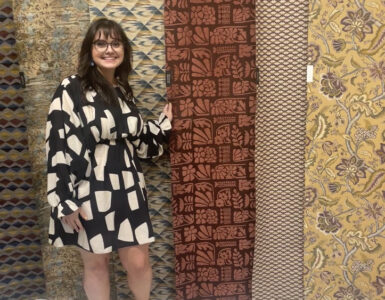Reposted from Jefferson’s online magazine, The Nexus. Written by By March 21, 2023
Using Invasive Species for Natural Dyes
The push for sustainability in the textile industry is gaining more momentum than ever, but what will that shift actually entail? “Sustainability is such a multifaceted question,” says textile design professor Becky Flax. Everything from the fiber to a textile is made from the chemicals used in dyeing, and processing can impact the environment.
One way that Flax promotes sustainability is by repurposing Pennsylvania’s invasive plant species into natural dyes. Together with biology professor Anne Bower, Ph.D., Flax recently tested if the roots of Japanese barberry, wineberry, and oriental bittersweet could be used to dye organic cotton and wool. Flax and Dr. Bower also investigated if using the invasive red oak acorn as a mordant—a substance that prevents the dye from running—intensified the root-based dyes. Their results, published in the Journal of Natural Fibers, showed that the three invasive plants and red oak acorn mordant all had potential applications as commercial natural dyes.
The roots, along with the mordant, yielded dyes tinted bright citron green, dusty rose, and chocolate brown. To assess the longevity of the dyes, Flax and Dr. Bower conducted tests to mimic laundering, perspiration, and rubbing up against other fabrics. Though the tests did lead to some fading, Flax says that doesn’t mean the dyes didn’t work; they just need to be used in the right circumstances. “I wouldn’t recommend this being used on children’s clothing because kids tend to stress and strain their fabrics a lot,” explains Flax. But, she says, the dyes could work well for a formal garment or winter apparel.
Flax hopes to develop more techniques to improve the dyes’ colorfastness and to determine if other parts of the plants, such as the stems or berries, can be used for dyes. She says that using local, readily available plants like these invasive species is a great way to reduce the environmental impact of the textile industry. “We’re coming up with a way to use these materials,” says Flax, “and not just sending them to waste or burning them.”
Republished from https://nexus.jefferson.edu/science-and-technology/jefferson-investigates-dyes-from-invasive-plants-covid-19-policies-that-worked-and-patient-centered-design/.







Add comment